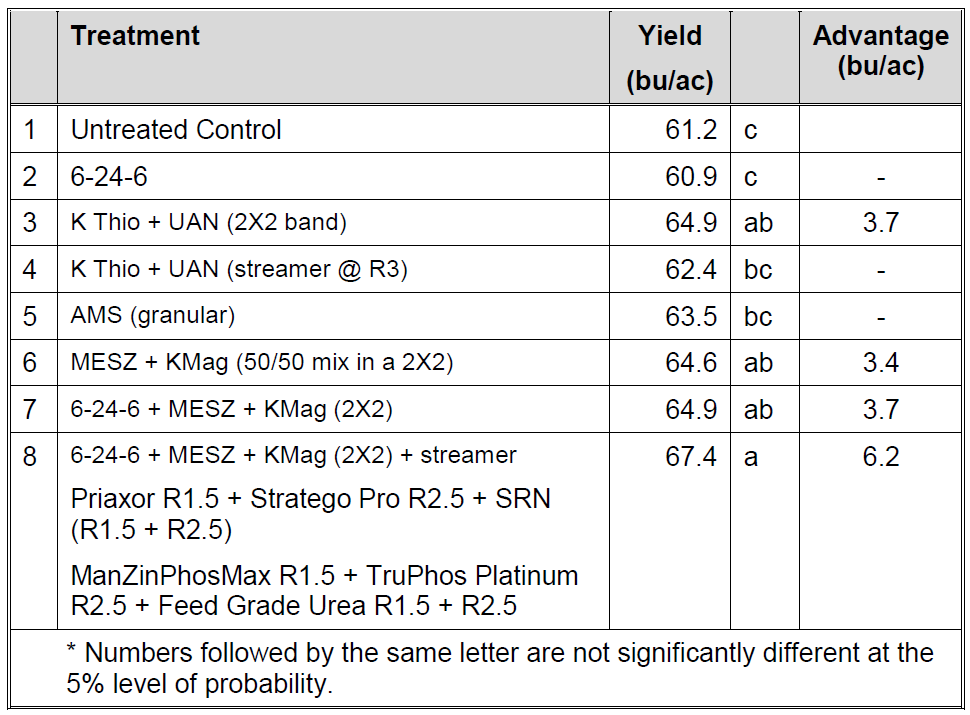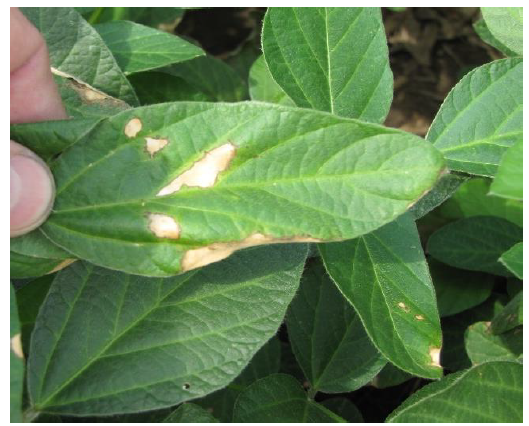Purpose
High yielding soybeans remove a considerable amount of phosphorous and potassium from the soil. Soybeans also require over 400 lbs/ac of nitrogen to produce a high yielding crop. Although most of this nitrogen is supplied by N fixation it raises the question of possible yield benefits from additional N. Yield responses to sulphur in crops like alfalfa and wheat have also raised the question if soybeans now require S. In recent years, yields have increased and crop rotations have shortened between soybean crops; this short interval is leading to nutrient deficiency symptoms being observed more often. There is evidence that foliar fungicides may be more beneficial in a short crop rotation.
This project was designed to assess if fertilizer including N and S, in a variety of blends and placements, can increase soybean yields. It also tested the strategy of combining fungicides with fertilizers to maximize yields.
Methods
Five trials were established in 2018. These five trials were established at Lucan, Bornholm, Elora, and Winchester. Two trials were set up at the Bornholm using different tillage systems and varieties. There were eight treatments randomized and replicated three times. Trials were planted with a Kearney 15” vacuum planter. All fertilizer treatments were applied by the planter at the time of planting. Previous research has shown that a 2X2 band provides a similar yield response to broadcast applications, especially in intermediate row widths and reasonable soil test levels.
Treatments Included:
- Untreated Control
- 6-24-6 @ 15 gal/ac (3 gal/acre product + 12 gal/ac water in furrow)
- K Thio + UAN (5 gal/ac K Thio + 10 gal/ac UAN, 2X2 band at planting)
- K Thio + UAN (streamer at R3), (5 gal/ac K Thio + 10 gal/ac UAN + 10 gal/ac water in streamer)
- AMS (granular), 100 lbs/ac (2X2 band at planting)
- MESZ + KMag (50/50 mix in a 2X2 at planting), 150 lbs/ac
- 6-24-6 + MESZ + KMag (2X2)
- 6-24-6 + MESZ + KMag (2X2) + streamer (same rates as treatments 2,4, and 6) + Priaxor R1.5 (180 ml/ac) + Stratego Pro R2.5 (230 ml) + SRN (R1.5+R2.5) @ 8 L/ac + ManZinPhosMax R1.5 + TruPhos Platinum R2.5 (1.0 L/ac + 0.67L/ac) + Feed grade urea R1.5 + R2.5 (10 lbs/ac + 10 lbs/ac)
Treatment fertilizer notes:
a) MESZ (12-40-0-10S-1Z) + Kmag (0-0-22-11Mg-21S) pre-mixed 50/50a) MESZ (12-40-0-10S-1Z) + Kmag (0-0-22-11Mg-21S) pre-mixed 50/50 (lbs/acre actual: 9N, 12P, 17K, 23S)
b) K Thio (0-0-25-27S), 1 gal/ac = 3.0 lbs/ac K and 2.1 lbs/ac S UAN (28%) = 2.9 lbs N per gallon (lbs/acre actual: 29N, 15K, 10.5S)
c) AMS (granular) 21-0-0-24 (lbs/acre actual: 21N, 24S)
Results
K Thio + UAN applied at planting time in a 2X2 band provided a yield gain of 3.7 bu/ac. When application of the same product was made at the R3 plant stage with a streamer no yield benefit was achieved. Although the amount of visual leaf burn was minimal this loss of yield response in that treatment was likely due to fertilizer burn. See picture #1. Although 100 lbs/ac of ammonium sulphate provided a small numerical yield response the yield gain was not considered statistically significant. Four of the five trials showed essentially no response to sulphur. A more balanced nutrient package including phosphorus, potassium, as well as sulphur, zinc, and magnesium provided a yield gain of 3.4 bu/ac. Combining all the treatments plus adding foliar fungicides increased yields by 6.2 bu/ac.
Table 1. Soybean Yield Response to Fertilizer

Soil tests for phosphorus ranged from 13-52 ppm so they were considered adequate for soybeans. Potassium levels were also considered adequate with most test locations ranging over 120 ppm. The Elora site was the only site considered low for K at 74 ppm.
Picture 1: Leaf burn from streamer application of K Thio and UAN

Summary
- Response to fertilizer can be significant even when soil tests are not considered low, approximately 3.4 bushels/acre in this study. Environmental conditions must be favourable to realize these yield gains. It should be noted that previous research has shown that the greatest likelihood of yield responses is associated with low testing fields. The yield gain in this study was not economically advantageous.1) Response to fertilizer can be significant even when soil tests are not considered low, approximately 3.4 bushels/acre in this study. Environmental conditions must be favourable to realize these yield gains. It should be noted that previous research has shown that the greatest likelihood of yield responses is associated with low testing fields. The yield gain in this study was not economically advantageous.
- The average sulphur response at these sites was not statistically significant. Additional sulphur trials are necessary to determine the best fit for sulphur in high yield soybean production system. Response may be soil type dependent.2) The average sulphur response at these sites was not statistically significant. Additional sulphur trials are necessary to determine the best fit for sulphur in high yield soybean production system. Response may be soil type dependent.
- A strategy of applying both fungicides and fertilizer provided over 6 bu/ac. Although this yield gain was not economically advantageous it was significant and needs further investigation.
Acknowledgements
We would like to thank the cooperators who lent their time and land to the project. We would also like to acknowledge AAC, GFO and OSCIA for their support of this project.
Project Contacts:
Horst Bohner, OMAFRA, horst.bohner@ontario.ca
